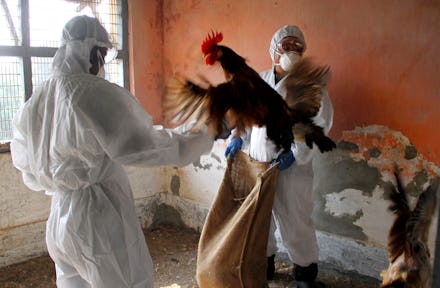H6N1 Bird Flu is Here, But There's No Reason to Panic

A new strain of bird flu has been discovered jumping hosts from birds to humans in Taiwan, once again sparking fears of a possible pandemic in the making. A 20-year-old deli employee developed flu-like symptoms and shortness of breath and was hospitalized for treatment in May. Although the young woman made a full recovery, after an examination, scientists discovered that she was infected with a strain of bird flu which had never been documented in humans before.
The new strain of flu has been designated H6N1, and is the second strain of avian flu reported to have infected humans this year, after H7N9. H6N1 in particular has been widely observed in chicken populations across Taiwan since the 1970s. While both of these strains seem fairly benign at the moment, H7N9 has already infected at least 145 people and killed 45.
Having only recently been discovered in humans, H6N1’s virulence is still unknown, but given the proclivity of these strains to mutate, it is possible that both strains (or perhaps an as-of-yet undiscovered strain) could become more threatening. There are several strains of flu that afflict avian populations, but are typically unable to manifest in humans. Scientists usually monitor the spread of more virulent strains in order to predict which ones are likely to be troublesome for people as well.
This is unfortunately more easily said than done, especially in regions like Asia where avian influenza is frequently discovered. A large part of the problem is the collision of massive populations of people and livestock. Livestock cultivation practices encourage keeping large numbers of birds in small confined spaces to increase productivity, which allows the spread of disease amongst the animals to occur more easily. Additionally, countries such as China have large live-bird markets, and many people prefer to purchase live animals and slaughter them for consumption at home. This greatly encourages the interaction of possibly infected animals with possible infectees. The lack of space combined with the density of people and animals is a literal invitation for viruses to change host species.
The increase in transmission of various strains of flu virus from bird to human populations is a serious problem because of the potential for an uncontrollable pandemic to occur. The most notorious instance of this in recent history might be the appearance of the H5N1 virus, an avian strain which has infected at least 600 people since 2003, and resulted in the deaths of about 60% of those infected.
While 600 people isn’t really that many on a global scale, scientists are very concerned about the speed by which avian influenza can pass from birds and spread amongst human populations. H5N1 isn’t very good at spreading in human populations, but H7N9 appears to be, and if this trend continues, the results could be devastating. It is not unthinkable for a virus such as H6N1 or H7N9 to eventually mutate into a strain with traits similar to the Spanish Flu which killed at least 50 million people worldwide in 1918. detecting mutations and preventing infections.